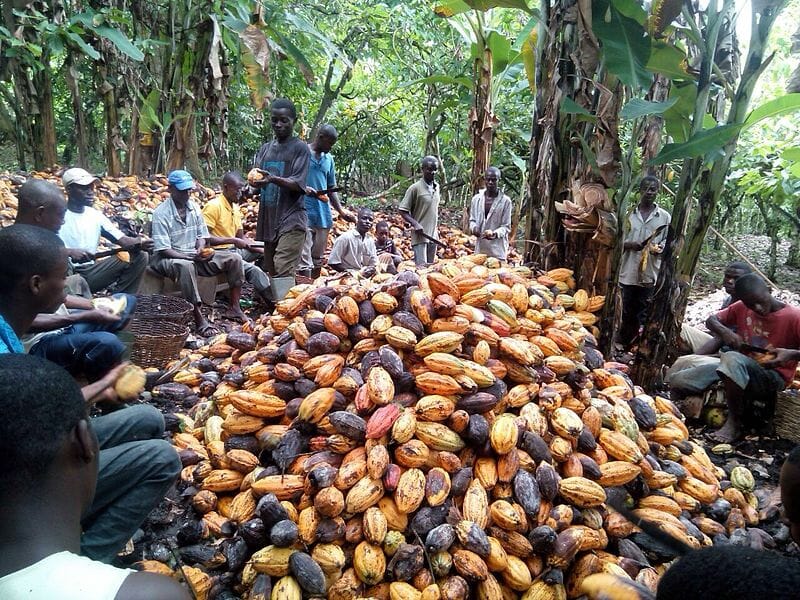Amid Climate Change, Company Acts to Keep Chocolate Coming
Fears that the supply of cocoa beans will dry up lead a confectionery giant to create a plan to help farmers have a sustainable future. Farmers collect cocoa beans during harvest. (Wikimedia Commons)
Farmers collect cocoa beans during harvest. (Wikimedia Commons)
If you have a sweet tooth, a liking not only for sugar-rich sweets but especially for chocolate, you’ve cause for celebration: the prospect of a climate chocolate threat is a little less likely.
Keeping the world supplied with chocolate is becoming more difficult as deforestation and climate change make it harder for farmers in the tropics to grow the trees that produce the cocoa beans.
Paying producers more for beans under the banner of Fairtrade certainly improved the lot of poor farmers, most of them small-scale cultivators, but that did not solve the long-term problem of providing enough cocoa to supply the huge world market.
The cocoa tree’s natural habitat is the lower storey of the evergreen rainforest, but cocoa farmers do not always grow their trees in the best conditions. The trees only thrive 10 degrees either side of the Equator, where they need sufficient warmth, rainfall, soil fertility and drainage if they are to flourish.
Clearing rainforest to make space for cocoa tree plantations is some farmers’ preferred practice, but it is not a sustainable way to maintain production.
“We pioneered Cocoa Life to address cocoa farm productivity alongside community development. We strive to not only empower cocoa farmers but also to help their communities thrive”
But, fearing that the supply of cocoa beans was in jeopardy and the price of their raw material would affect production, one of the world’s largest manufacturers is now to invest US$400m by 2022 to help 200,000 cocoa farmers secure a long-term future.
The scheme, called Cocoa Life, is helping farmers in six key cocoa-growing countries: Ghana, Côte d’Ivoire, Indonesia, India, the Dominican Republic and Brazil.
The company responsible, Mondelēz International, which owns brands like Cadbury, Suchard and Milka, believes many cocoa-growing regions could be wiped out unless action is taken.
Cathy Pieters, director of the Cocoa Life programme at Mondelēz, told the Climate News Network: “The challenges in cocoa are becoming more diverse and complex. In fact, some reports show current cocoa-producing regions may no longer be suitable for cocoa production in the next 30 years if we don’t take action.
Expecting change
“Our approach to climate change is deliberate because we expect a change to happen – a transformation. As one of the largest chocolate makers in the world, we are mobilising farmers and their communities to prioritise forest protection.”
Key to the programme is educating farmers, helping women by providing finance and stopping child labour, and also improving the environment. The company is helping farmers prevent further destruction of rainforest and planting trees around cocoa farms to protect them and recreate the habitat in which trees are most productive.
In this way farmers are producing far more cocoa beans from the same area of land. This year the programme has planted more than a million trees to restore the forest canopy.
Cocoa Life was launched in 2012 and to the end of last year had trained more than 68,000 members of the cocoa-farming community in best practice to ensure a sustainable industry. Cocoa saplings and shade trees needed to replicate rainforest conditions had been distributed to 9,600 farmers.
Industry example
The company says that by the end of 2017 it had increased the amount of its cocoa from sustainable sources by 14 percentage points to 35% and reached 120,000 farmers, 31% more than in 2016.
The potential crisis in the cocoa-growing industry and the threat of climate change have led other manufacturers to embark on similar schemes, and 11 companies have now joined together in a World Cocoa Foundation alliance to protect rainforest from further destruction by cocoa farmers looking for new land.
Although Mondelēz is protecting its own interests by ensuring its cocoa supply chain, Cathy Pieters is clear that the programme is much more than that alone: “We pioneered Cocoa Life to address cocoa farm productivity alongside community development. We strive to not only empower cocoa farmers but also to help their communities thrive.
“We help them find real solutions like diversifying their income beyond the farm, which in turn develops their capacity to stand strongly on their own feet. I believe when we involve farmers as part of the solution, we see lasting, positive change happen.”
Your support matters…Independent journalism is under threat and overshadowed by heavily funded mainstream media.
You can help level the playing field. Become a member.
Your tax-deductible contribution keeps us digging beneath the headlines to give you thought-provoking, investigative reporting and analysis that unearths what's really happening- without compromise.
Give today to support our courageous, independent journalists.









You need to be a supporter to comment.
There are currently no responses to this article.
Be the first to respond.